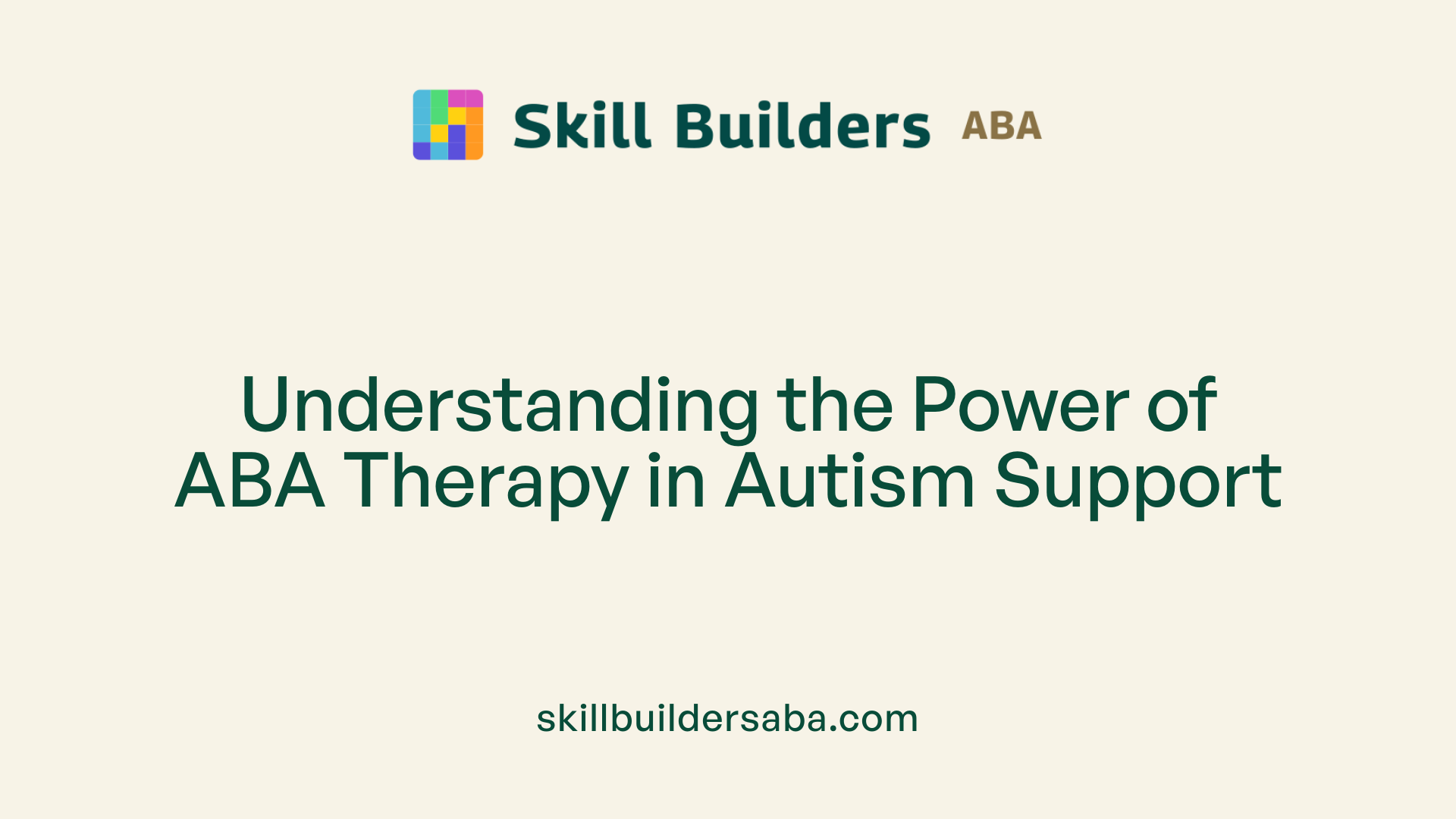
How to prevent escape-maintained behavior
Effective Strategies to Manage and Prevent Escape-Maintained Behaviors in Autism Therapy
Understanding Escape-Maintained Behavior in Autism
Escape-maintained behaviors are common in individuals with autism spectrum disorder (ASD) and present significant challenges in learning and social engagement. These behaviors occur as attempts to avoid or escape unpleasant tasks, social interactions, or environments. Preventing such behaviors is crucial for enabling greater participation and success in therapy and daily life. This article explores evidence-based approaches grounded in Applied Behavior Analysis (ABA) therapy to prevent and reduce escape-maintained behaviors, highlighting foundational principles, assessment methods, tailored interventions, and practical strategies.
What is Applied Behavior Analysis (ABA) Therapy and its Role in Autism Support?

Understanding ABA Therapy
Applied Behavior Analysis (ABA) therapy is a science-based intervention focused on improving social, communication, and academic skills in individuals with autism spectrum disorder (ASD). It works by analyzing behaviors and identifying the environmental triggers and consequences that influence them.
How ABA Supports Individuals with Autism
ABA uses strategies like positive reinforcement to encourage desirable behaviors and reduce problematic ones. By tailoring programs to each individual’s needs, therapists help build skills that support independence and improve daily functioning. For example, teaching alternative communication methods or adjusting tasks to reduce escape behaviors are common ABA techniques.
Goals and Effectiveness of ABA
The primary goal of ABA is to increase meaningful behaviors and decrease those that interfere with learning or social engagement. Evidence shows ABA is highly effective, especially when started early and delivered intensively. Therapists use ongoing assessments to monitor progress and modify approaches, ensuring the best outcomes for each person with autism.
Who Provides ABA Therapy? Qualifications and Expertise of Providers

Who typically provides ABA therapy services, and what qualifications do these professionals have?
ABA therapy services are usually delivered by a team of specialized professionals, including Board Certified Behavior Analysts (BCBAs), Registered Behavior Technicians (RBTs), and sometimes other trained staff with education in behavioral science.
BCBAs typically have a master's degree or higher in applied behavior analysis, psychology, or a related field. They must complete rigorous supervised fieldwork hours and successfully pass the Behavior Analyst Certification Board (BACB) exam. These credentials authorize BCBAs to design, oversee, and manage individualized ABA intervention programs based on functional behavior assessments and data analysis.
RBTs provide direct implementation of ABA interventions under the supervision of BCBAs. Their training includes certification requirements centered on ethical implementation and hands-on skills but does not encompass independent clinical decision-making.
The roles of these professionals complement each other: BCBAs lead the design and adaptation of evidence-based treatment plans focused on behaviors like escape-maintained challenging behaviors common in autism, while RBTs carry out the day-to-day therapy activities.
ABA providers also require strong skills in communication, empathy, data collection, and individualized treatment planning to ensure therapy is responsive to each person's needs and progress. Additionally, caregiver training and telehealth services have become important components to provide accessible, consistent support beyond clinical settings.
Core Principles of Behavioral Analysis in Addressing Escape-Maintained Behaviors

What are the core principles of behavioral analysis applied in autism therapy?
Behavioral analysis in autism therapy centers around the understanding that behaviors are shaped by environmental factors and maintained by their consequences. One of the foundational principles is reinforcement—specifically, using positive reinforcement to increase desirable behaviors while decreasing problematic ones.
A critical first step is conducting a Functional Behavior Assessment (FBA), which identifies why a behavior occurs. For escape-maintained behaviors, the problematic actions are reinforced by successfully avoiding or escaping unpleasant tasks or stimuli. Recognizing this function allows therapists to design effective, personalized interventions.
Functional Communication Training (FCT) is a widely used technique that teaches individuals alternative ways to communicate their desire to escape demands, replacing problematic behaviors with more appropriate communication responses (FCRs). This training uses an initial dense schedule of reinforcement to strengthen new behaviors.
Behavioral analysis employs methods such as prompting—providing cues to encourage the desired response, fading—gradually reducing prompts or reinforcers to increase independence, and chaining—linking simpler behaviors in sequence for complex tasks. For example, chained schedules require completion of task components before escape or reinforcement is granted, helping shape tolerance to demands.
Combining positive reinforcement with negative reinforcement (escape) often leads to more effective and rapid behavior change. Interventions also integrate consistent data collection and progress monitoring to ensure that behaviors improve as planned.
Overall, informed by these principles, behavioral analysis offers systematic, evidence-based, and personalized approaches to reduce escape-maintained behaviors and enhance communication and engagement in individuals with autism.
Functional Communication Training: Replacing Escape Behaviors with Positive Alternatives

What is Functional Communication Training (FCT)?
Functional Communication Training (FCT) is a highly effective intervention designed to reduce problem behaviors, particularly in individuals with autism. It works by teaching alternative communication methods that serve the same function as the problem behavior, thereby allowing the individual to express their needs more appropriately and effectively.
How is Functional Analysis (FA) Used in FCT?
The foundation of FCT involves conducting a Functional Analysis (FA). FA identifies the environmental factors that maintain problem behaviors, such as escape from tasks or demands. This step ensures that the intervention targets the specific reasons why the problem behavior occurs, making the treatment function-based and tailored.
What Are Functionally Equivalent Communication Responses (FCRs)?
Once the function of the problem behavior is identified, FCT teaches a Functionally Equivalent Communication Response (FCR). These are alternative, socially acceptable communication methods that replace the problem behavior. For example, instead of engaging in challenging behavior to escape a task, an individual might be taught to request a break or help. Initial reinforcement for these communication responses is provided on a dense schedule to encourage their adoption.
How Is Schedule Thinning Implemented in FCT?
After establishing the FCR, the reinforcement schedule is gradually thinned to make the behavior sustainable in natural environments. This is often achieved using multiple schedules that signal when reinforcement is available (S+) and when it is not (S−). For escape-maintained behaviors, chained schedules can be used, which require completion of certain tasks before access to reinforcement is granted. Combining positive reinforcement (such as access to preferred items) with negative reinforcement (escape from demands) accelerates this process. Embedding alternative reinforcement during break periods further reduces problem behavior and enhances compliance.
Together, these strategies provide a structured, evidence-based approach to replacing escape behaviors with positive communication alternatives, improving outcomes for individuals with autism.
Antecedent and Environmental Strategies to Prevent Escape Behaviors

Adjusting Task Parameters to Reduce Escape Behaviors
Modifying task parameters is an effective antecedent strategy to minimize escape-maintained problem behaviors in individuals with autism. Adjustments may include changing the task length, order, novelty, or pace to make demands more manageable and less aversive. For example, starting with shorter tasks or easier steps can build tolerance, while gradually increasing difficulty helps maintain engagement.
Using Visual Schedules with Preferred and Non-Preferred Tasks
Visual schedules that clearly indicate both preferred and non-preferred activities help create predictability and reduce anxiety about upcoming tasks. These schedules, which can be picture or written formats, allow individuals to anticipate when breaks or preferred activities will occur, supporting on-task behavior and decreasing escape responses.
Incorporating Individual Interests and Providing Choices
Including a person's interests in the environment and offering choices about activities empower them and promote cooperation. Choices can relate to task order, types of tasks, or break activities, which helps build momentum and a sense of control that counters escape-driven behaviors.
Implementing Noncontingent Escape and Demand Fading
Noncontingent escape (NCE) delivers breaks based on the passage of time regardless of behavior, initially using dense reinforcement schedules tailored with individualized signals. Over time, demand fading gradually reintroduces and increases task demands while reducing reliance on breaks. This approach lessens escape behavior by promoting tolerance and reducing the aversiveness of tasks without sudden increases in demands.
Overall, antecedent strategies that create a supportive environment, increase predictability, and reduce task aversiveness play a critical role in preventing escape-maintained behaviors in children with autism.
Consequence-Based Techniques: Differential Reinforcement and Chained Schedules

What is Differential Reinforcement of Alternative Behavior (DRA)?
Differential reinforcement of alternative behavior, or DRA, is a cornerstone strategy used to reduce problem behaviors by reinforcing appropriate, alternative behaviors while withholding reinforcement from the problem behaviors. This approach encourages individuals to replace challenging behaviors with constructive actions that produce similar outcomes. Remarkably, DRA remains effective even when treatment fidelity is not perfect, highlighting its robustness in clinical practice.
How Does Escape Extinction Work with Demand Fading?
Escape extinction involves preventing the individual from escaping or avoiding demands, thereby decreasing the escape-maintained behavior over time. When combined with demand fading, in which demands are gradually reintroduced in manageable amounts, this technique helps lessen problem behavior while increasing task compliance. The gradual reintroduction supports tolerance to demands without overwhelming the individual.
What are Chained Schedules and How Do They Help?
Chained schedules require the individual to complete a series of specified tasks before access to reinforcement is provided. This method is particularly effective for escape-maintained behaviors, where problem behavior is aimed at avoiding or delaying tasks. By mandating task completion first, chained schedules build compliance and reduce escape behavior through clear contingency.
Why Combine Positive and Negative Reinforcement for Schedule Thinning?
Successful schedule thinning—the process of extending intervals between reinforcement—is facilitated by combining positive reinforcement (such as tangible rewards) with negative reinforcement (escape from demands). This blended approach works faster and more completely than either reinforcement type alone. For example, allowing brief breaks (negative reinforcement) alongside access to preferred items (positive reinforcement) signals when reinforcement is available (S+) and when it is not (S−), aiding transition to less frequent reinforcement without resurgence of challenging behaviors.
Integration in Practice
Research and clinical application with children demonstrating escape-maintained challenging behavior support these methods' effectiveness. Using DRA alongside carefully managed chained schedules and combined reinforcement strategies offers a comprehensive consequence-based framework to reduce problem behavior, promote alternative communication, and enhance compliance with demands.
| Technique | Description | Effectiveness Details |
|---|---|---|
| Differential Reinforcement (DRA) | Reinforces alternative behaviors, withholds reinforcement for problem behavior | Effective even with some treatment fidelity errors |
| Escape Extinction + Demand Fading | Blocks escape behaviors while gradually increasing task demands | Reduces problem behavior and increases compliance |
| Chained Schedules | Requires completing tasks before reinforcement | Particularly effective for escape-maintained behaviors |
| Combined Positive & Negative Reinforcement | Uses both reinforcement types to aid schedule thinning | Leads to faster and more complete reduction in challenging behavior |
Tailoring Interventions: Individualized Approaches for Unique Needs

Importance of functional behavior assessment (FBA) and decision trees
ABA therapy begins with a Functional Behavior Assessment (FBA), a systematic process used to identify the reasons behind specific behaviors, especially escape-maintained behaviors common in individuals with autism. Conducting a thorough FBA reveals environmental variables and helps determine whether behaviors are maintained by escape, access to tangible items, or attention. This foundational understanding allows clinicians to select interventions closely aligned with each individual’s needs. Decision trees aid this process by guiding clinicians through choices for treatment based on assessment data, ensuring interventions target the precise function of behavior.
Personalized treatment planning and progress monitoring
Individualized treatment plans are created from FBA results, tailoring goals to each client’s strengths, challenges, and preferences. These plans use evidence-based strategies such as functional communication training (FCT) to replace problem behaviors with alternative communication responses, noncontingent escape (NCE) schedules to provide breaks, and differential reinforcement to encourage appropriate behaviors. Progress is closely monitored through ongoing data collection, allowing continuous adjustment of interventions to maximize effectiveness. This dynamic approach supports meaningful behavior changes and skill acquisition.
Combining ABA with complementary therapies
While ABA forms the behavioral foundation, combining it with complementary interventions enhances outcomes. Speech therapy may improve communication skills, occupational therapy addresses sensory or fine motor challenges, and social skills groups facilitate peer interaction. This multidisciplinary approach ensures comprehensive support, addressing all areas relevant to development and social integration.
Use of data collection and telehealth services
Effective ABA interventions rely heavily on detailed data collection and progress reporting to guide decisions. Modern functional analysis engines and digital tools streamline this process, enabling precise tracking of behavior and treatment effects. Telehealth services have expanded access to qualified clinicians, allowing families in diverse locations to receive individualized ABA support. Through virtual sessions, caregiver training is feasible remotely, promoting consistency and generalization of strategies across settings.
In summary, ABA therapy is most effective when customized through thorough assessment, individualized planning, integration of supportive therapies, and utilization of technology for data-driven, accessible intervention delivery.
Evidence Supporting ABA and FCT Approaches in Reducing Escape Behaviors

What Evidence Supports the Effectiveness of ABA Therapy for Individuals on the Autism Spectrum?
Applied Behavior Analysis (ABA) is a highly validated intervention grounded in behavior science principles. Extensive research, including numerous studies and meta-analyses, has confirmed its effectiveness in improving critical developmental domains for individuals with Autism Spectrum Disorder (ASD). ABA has shown considerable success in enhancing language abilities, social skills, and adaptive behaviors through strategies like reinforcement, prompting, and task analysis.
Short-term, structured ABA programs lead to measurable improvements in social-emotional development, behavioral flexibility, and IQ when implemented early and with parental involvement. ABA's individualized, data-driven approach makes it particularly effective for reducing problem behaviors such as escape-maintained behaviors by modifying antecedents and consequences.
What Research Exists on Functional Communication Training?
Functional Communication Training (FCT) is an ABA-based intervention designed specifically to reduce problem behaviors by teaching individuals alternative communication responses that serve the same function as the maladaptive behavior. Research demonstrates that FCT effectively reduces escape-maintained challenging behaviors by identifying the environmental triggers through functional analysis and then teaching a functionally equivalent communication response (FCR).
FCT uses reinforcement on dense schedules initially and incorporates schedule thinning strategies, like multiple and chained schedules, to gradually reduce dependence on continuous reinforcement. Studies have shown that FCT combined with methods such as positive reinforcement and negative reinforcement accelerates schedule thinning while reducing challenging behaviors.
What Outcomes Have Been Observed for Language, Compliance, and Behavior Reduction?
Clinical research involving children with escape-maintained challenging behaviors confirms that ABA and FCT result in lower levels of problematic behaviors, higher compliance, and faster progress through schedule thinning. Teaching functionally equivalent communication responses helps children express needs effectively, reducing frustration and escape behaviors.
Additionally, antecedent strategies such as task modification, providing choices, and using visual schedules build engagement and momentum for on-task behavior. Consequence strategies like differential reinforcement of alternative behaviors (DRA) maintain desired behaviors by reinforcing appropriate communication and withholding reinforcement from problem behaviors.
Together, these evidence-based approaches improve language use, increase compliance with demands, and significantly decrease escape-maintained challenging behavior, enhancing overall quality of life for individuals with autism.
Supporting Caregivers and Ensuring Long-Term Success

Caregiver Training and Involvement
Caregiver involvement is essential for the success of interventions targeting escape-maintained behaviors in individuals with autism. Training caregivers empowers them to implement strategies consistently, recognize signs of challenging behavior, and support skill acquisition at home. By understanding the underlying functions of behaviors, caregivers can effectively reinforce alternative communication responses and use differential reinforcement to reduce problem behaviors.
Use of Visual Supports and Scheduled Breaks
Visual supports such as picture schedules can enhance predictability for individuals by clearly signaling when tasks will happen and when breaks are available. Scheduled breaks—planned periods where the individual can rest or escape demands noncontingently—help reduce the need for escape behaviors by providing controlled relief from aversive stimuli. These tools foster independence and reduce anxiety associated with task demands.
Promoting Consistency and Generalization of Skills
Consistency across environments and caregivers is crucial for sustaining behavioral improvements. Caregivers should collaborate with therapists to use uniform cues, reinforcement strategies, and communication methods. Generalizing skills beyond therapy sessions to everyday settings encourages functional use of replacement behaviors, improving social engagement and learning.
Telehealth for Ongoing Support and Collaboration
Telehealth services provide accessible, multidisciplinary support that can strengthen the caregiver-therapist partnership. Remote coaching, data sharing, and progress monitoring enable timely adjustments to treatment plans. This technology helps maintain treatment fidelity, assures continued caregiver guidance, and supports long-term behavior change even when in-person sessions are limited.
Moving Forward: Integrating Strategies to Prevent Escape-Maintained Behaviors
Preventing escape-maintained behaviors in individuals with autism is achievable through a blend of thorough assessment, individualized ABA interventions, and consistent supports. Functional communication training, combined with antecedent and consequence-based strategies such as schedule thinning, chained schedules, and differential reinforcement, empowers individuals to replace avoidance with effective communication and task engagement. Tailoring treatment plans to each person's unique profile, providing caregiver education, and utilizing tools like visual schedules and telehealth expand the reach and sustainability of these approaches. Continued research validates ABA as a cornerstone therapy, fostering improved learning, social participation, and quality of life. By embracing these evidence-based strategies, therapy providers and families can collaboratively reduce escape behaviors, promoting success across environments and stages of development.
References
- Treatment of Escape-Maintained Challenging Behavior ...
- Function-Based Interventions for Escape-Maintained ...
- What are Escape Behaviors?
- Understanding and Managing Escape Behaviors in ABA ...
- The effectiveness of applied behavior analysis program ...
- The effectiveness of applied behavior analytic interventions ...
- Effects of Applied Behavior Analysis on individuals with ...
Reach Out Today
Learn more about how we can support your child’s growth and development. Contact us to discuss our services and availability in your area.
.svg)